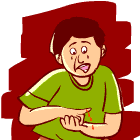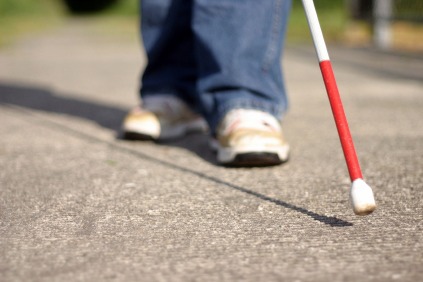Although you may get very scared and your child petrified by the sight of blood, it is actually quite useful if is oozing or dripping out of a wound. It washes away a lot of dirt and germs that would be difficult to clean otherwise.

Bleeding []
Inspect the wound to ensure that there is no glass or foreign body sticking out of it. If there is, do not press on it and do not try to remove it. Seek a doctor’s help.
If there isn’t press firmly on the wound using a gauze pad, the inner folds of a clean handkerchief, or, if you cannot find anything, your bare hand.
If possible, raise the site of the wound above the level of the child’s heart. If the wound edges fall open, try to held them closed as you press. Maintain the pressure for at least three minutes.
Release the pressure gently but do not remove the pad as you will disturb any clotting that has already started. If the wound is still bleeding, try two more minutes of pressure. If this does not help, take your child to the nearest health center. The bleeding will not be dangerous, but the wound may be too deep and may require stitches to help it close.
Dress the wound even as it is oozing over the existing pad. If this dressing becomes soaked, add another layer over the top. Do not remove the first layer until bleeding has stopped.
Dangerous bleeding: If blood spurts from a wound, it suggests a cut a artery. Each heartbeat will push blood out of the wound with a lot of force. The blood pressure will not allow blood to clot either.
Act fast, press hard on the spurting wound. Use a handkerchief, or anything else that could be used as a pad, or your bare hands if you cannot find anything. Try to raise the injured part above the heart level to reduce the flow of blood.
If blood continues to spurt around your fingers, find an underlying bone to compress it against. Try just above the wound. If the bleeding slows, you have found the right “pressure point.” Don’t move your fingers or relax the pressure.
If the wound is in a place where you cannot apply pressure properly, like the groin or the armpit, make the child lie down and use your closed fist or a balled handkerchief to press the wound up against the bone.
If you can carry the child without releasing pressure, take him along with you to the telephone or to a place where you can scream for help.
If you must leave him to get help, put a firm pad and bandage it with anything you can find close at hand. Ensure that your “pressure bandage” has stopped the bleeding as your hand had and then go for help — but fast.
Don’t drive the child to hospital yourself if there is someone else nearby. If the pressure bandage should fail and the wound starts bleeding again, you will have to stop.
Don’t try to use a tourniquet (a bandage which is twisted tight with a stick to check bleeding) to control arterial bleeding. It could be dangerous , since it cuts off blood from all the vessels to the damaged area, not only the cut one.
Safety tips:
When your child is very small, anything sharp can cause damage. Keep anything with rough, sharp edges out of reach. Knives, scissors, screw drivers are other pointed tools are best kept on a rack screwed on the wall out of the child’s reach.
Cutlery, sewing materials like needles, fine threads, pins, writing materials, electrically powered appliances like iron, electric heaters, grass cutters, hedge trimmers, grinders, or saws should be kept in locked cabinets away from the child’s reach.










